Silk-Stocking Mats:
The Hooked Mats of the Grenfell Mission of Newfoundland and Labrador
The quiet months of February and March were known as the "matting season" along the rugged coast of northern Newfoundland and Labrador. It was a time of respite from the fishing season. Generations old by the time the Grenfell Mission began, the roots of mat hooking lay with the founding English and Scottish settlers. The women all hooked, most from their earliest childhood.
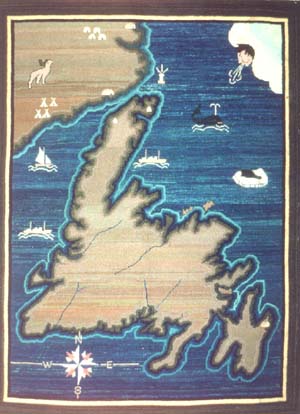
The Birth of "The Industrial"
In 1892, when Dr. Wilfred T. Grenfell arrived from England, he met courageous, hardworking people who were fighting terrible odds against chronic disease, hunger, poverty and exploitation. From his determination to alleviate their distress, Grenfell's medical mission began. His conviction that outright gifts of money, food and clothing would offer no long term help led to the development of a cottage industry known as "the Industrial," which produced distinctive handicrafts including hooked mats. The mat industry rose to peak production in the late 1920s and early 1930s. It began to decline as the effects of the Great Depression reached the region and fell off dramatically after World War II.
In 1905, Grenfell met Jessie Luther, an American woman who had set up a sanitarium with crafts as part of the treatment. Excited by her methods Grenfell encouraged her to come north. In 1906, Luther journeyed to the tiny settlement of St. Anthony on the northeastern most tip of Newfoundland to establish a weaving project by which the local women could augment their families' meagre and unreliable income from fishing.
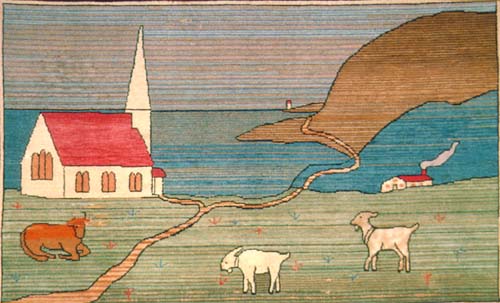
How to Hook Mats
Mat hooking was overlooked as a cottage industry at first. Unlike weaving, hooking required only simple frames. Each home already had a mat frame made from four pieces of wood lashed together. The hook was simply a filed-off bent nail pounded into a stump of wood whittled to fit the woman's hand. The first mention of a matting industry occurs in Jessie Luther's journal on January 29, 1908: "This afternoon was the beginning of the matting club. Several women came but evidently with the idea of looking around before committing themselves."
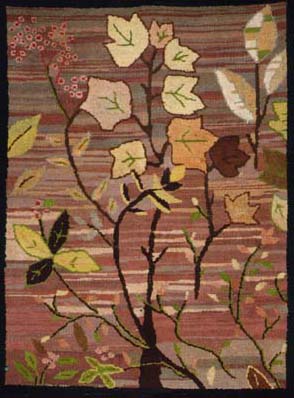
Most probably felt no need for lessons in a craft they had already mastered. They were hooking some interesting mats of their own design – blocks or triangles arranged like a patchwork quilt, as well as floral motifs. They would offer to sell these mats to Dr. Grenfell or Miss Luther in return for medical services. Luther designed some mats herself using local motifs: deer, seals, walrus, komatiks, jellyfish, ducks, bears and rabbits treated as borders around a plain centre.
The earliest mat hookers used new wool material and outing flannel, which was purchased or donated from benefactors. Fabrics were dyed in an enamelled pan over a little Florence oil stove. They tried madder and indigo vegetable dyes and experimented with spruce twigs mordanted with alum, producing a lovely fawn colour. They tested copperas (iron sulfate) with lime, resulting in an iron-rust tone. And they used dye made from Paten bark powder, used locally for the sails of the fishing boats to prevent mildew, yielding a soft, pinkish brown shade. However, the scarcity of time, space, proper equipment and expertise made the use of natural dyes short-lived. A journal entry in 1906: "The long-delayed box of dyes ... has at last arrived." To make the mats, workers were given a kit consisting of a design drawn on burlap (called "brin" locally) and 12 to 18 yards of hooking materials torn into 1/4" x 10" long strips. A visual aid, usually a small coloured drawing, or scraps of hooking material pinned to the appropriate area of the mat were included with the kit to indicate the correct colour scheme. The standard size mat measured 64 by 104 cm.
Kits were distributed to the mat hookers by an Industrial worker travelling along the coast by boat or dog team. Luther, herself, travelled thousands of miles along the rocky Labrador coast by dog team and ship, giving out bundles of raw materials and picking up the finished work.
Grenfell's marriage in 1909 to the American socialite Anne McClanahan, whom he had met on shipboard as he travelled to Europe, and the friction that arose from her increasing role in the Industrial led to Jessie Luther's resignation in 1914.
The Mission's Impact on the Mat Hooking Industry
To the mat hooking industry, the mission brought standardization, colour harmony and incentive. Sixteen mission picture mats, many designed by Grenfell himself, were in production by 1916. Distinctly northern images – dog teams, snowy owls and polar bears – were now in the centre of the mat.
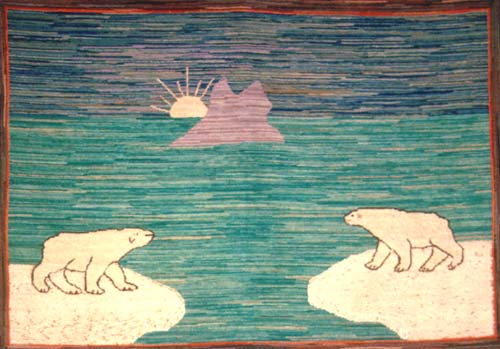
A Plea for Silk Stockings
In 1928, the Industrial Supervisor M.A. Pressley-Smith sent out a plea through the mission's quarterly publication, Among the Deep Sea Fishers, "Save Your Old Silk Stockings! When your stockings run let them run to Labrador! We need silk stockings and underwear in Unlimited Quantities! Please send your silk stockings and underwear no matter how old or worn! We need such silk and artificial silk for the making of hooked rugs of a beautiful type!" Silk stockings when dyed to beautiful soft hues, helped propel the mat industry into its peak production years of 1926 to the early 1930s. By the winter of 1929 3,000 mats had been hooked and revenues from sales had risen from $27,000 in 1926 to $63,000 in 1929. New designs were in production. Geometric and floral patterned "scrap mats", often of the mat hooker's own design, were popular and provided an interesting contrast to the picture mats.
Progression of Industrial Work
In the late 1920s, the Industrial work progressed with an assembly line efficiency. Many workers travelled by dog team or on foot, a journey which often took days to make. On a card, mission staff noted whether the family was in need, the kind and grade of her work, and the amount of work she had been given. The finished mats were then weighed (to assure that the materials that went out were returned), graded and paid for.
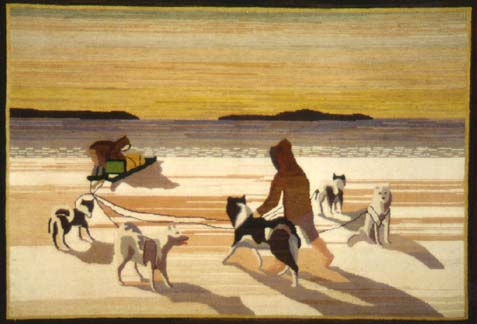
During the 1930s, enthusiastic mission volunteers toured the resort areas of New England and New York, holding sales. Retail shops were opened in New York City and in Philadelphia. The establishment of the Dog Team Tavern in Ferrisburg, Vermont, in 1931 provided additional distribution for the products.
Trouble for the Industry
A decline in sales due to lack of mission funds, a surplus of mats, and a dearth of new markets brought trouble to the Industrial's efforts just when the people needed the work the most. The fish catch had failed and nearly 20,000 people were on government relief at six cents per day. In 1932, M.A. Pressley-Smith, a Scotswoman who had come to the mission in the mid-1920s, wrote:
It is simply heartbreaking to have everyone on the Coast clamouring for two or three mats. We are making up the last bags to be given out this Tuesday. Then we are through.
Supplies of materials were depleted and the mission publication pleaded for donations of clothing, silk stockings and bolts of "cheap-grade" flannelette. "We can not fail them now," Pressley-Smith concluded in her appeal. Although the mat hooking craft did not die, the Depression had reached the North and the Industrial never recovered fully. After Grenfell died in 1940, the spirit behind the Industrial faded. World War II closed markets, created transportation and supply problems, and caused costs to rise. With only nylon stockings available after the war the program changed.
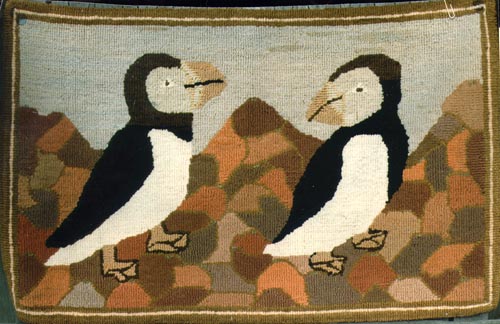
Mat Hooking Benefits
Mat hooking has had wide-ranging benefits for the women of Labrador and northern Newfoundland. In the early days of the mission their mat hooking income would only provide the bare necessities: clothing and medicines. But as the industry and their income grew, the goods they were able to purchase with "mat money" inspired a new pride. Women could earn their own livelihood and were no longer forced to marry young. The men looked at the women with new respect and proudly spoke of their own contributions to the art, sometimes offering technical advice on a mat design. They willingly hauled their wives by dogsled or rowed them to St. Anthony on Mat Day.
Lady Grenfell (Dr. Grenfell was knighted in 1929) was particularly active in finding scholarships to enable promising students to go to the U.S. to Berea College, Pratt Institute, and other art schools. These students returned home to teach and enrich the lives of others.
In interviews conducted in 1992 and 1993, the older women recalled their mat hooking days. "There's nothin' in the world I likes better'en hookin' a mat." "I liked the geese, and the shadin' of the sky was all like rainbow colours." These comments were echoed frequently by the women whose mothers had hooked for the Industrial and who had hooked themselves in the late 1930s and 1940s.
Changing Attitudes
With progress came a change in attitudes. Believing that only poor women hook, mothers have not encouraged their daughters to continue the tradition, with the result that mat hooking is now carried on by only a handful of women. The industry continues today under the independently owned Grenfell Handicrafts label in St. Anthony. The mats are original, copyrighted Grenfell patterns, hooked with the same precision in wool, but the colours lack the subtleties so cherished in the old mats.
A Distinctive Art Form
The original flawlessly-hooked mats are now considered an art form and are eagerly sought-after. They are distinctive in their almost universal use of straight horizontal line hooking and their use of every hole in the brin, which results in as many as 200 stitches per square inch. They have survived the test of time as folk art. Those who admire the handiwork of these unnamed women know that into each mat there went a genuine pride of workmanship and a spirit of individuality and commitment.




